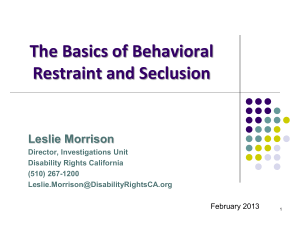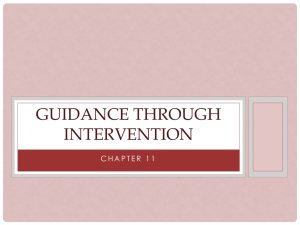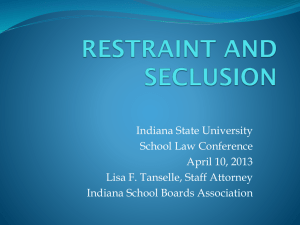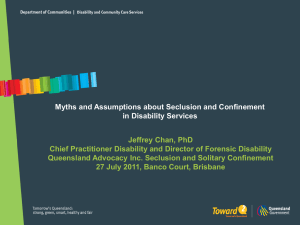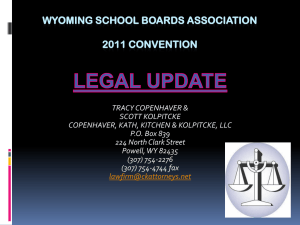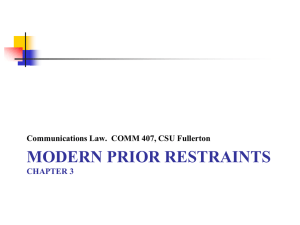Guidelines for Minimizing the Use of Seclusion and Restraint
advertisement
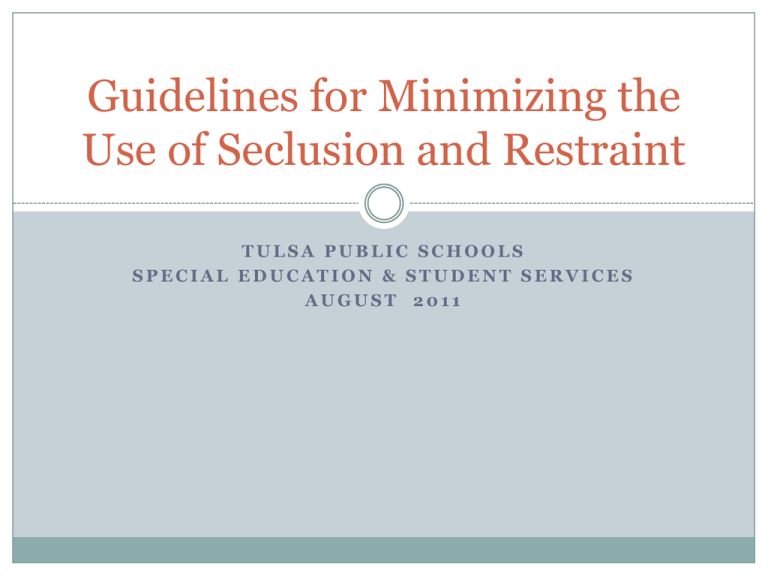
Guidelines for Minimizing the Use of Seclusion and Restraint TULSA PUBLIC SCHOOLS SPECIAL EDUCATION & STUDENT SERVICES AUGUST 2011 Conditions on the use of physical restraint and/or seclusion May not be used for the purpose of managing behavior May be used only in an emergency and when there is an imminent risk of harm or danger. Imminent risk of harm or danger: The immediate and impending threat of a person causing serious bodily injury to self or others. Serious bodily injury involves: A substantial risk of death; Extreme physical pain; Protracted and obvious disfigurement; or Protracted lost or impairment of the function of a bodily member, organ or mental faculty. May be used only as a last resort Conditions on the use of physical restraint and/or seclusion Should never be used if the student has a known medical/physical condition that would make the intervention dangerous for the student May be used only by staff members trained in Mandt, First Aid and CPR Seclusion Involuntary confinement of a student alone in a room or area that the student is physically prevented from leaving. The student doesn’t choose to be there. No one else is allowed to be in the room with the student. The student is forced to remain in the assigned room/area and is not allowed to leave. Conditions on the use of seclusion for students with disabilities Seclusion must end when the student is not longer a threat of harm or danger to self or others. Periods of seclusion may be extended past the point of imminent threat of harm only if waiting for law enforcement to arrive. Never attempt to transport a student to a seclusion room unless the student can safely be moved While in seclusion the student must be continuously monitored visually and aurally. Conditions on the use of seclusion for students with disabilities The student will be: Permitted to use the restroom upon request Provided water to drink upon request Staff will take immediate action at signs of medical distress. Seclusion rooms must be inspected at least annually for adherence to safety requirements. Physical Restraint Any method of one or more persons limiting or restricting another person’s freedom of movement, physical activity, or normal access to his/her body. It is a means for managing that person’s movement, reconstituting behavioral management and establishing and maintaining safety for the student, other students and staff. Physical restraint does NOT include: Physical escort (temporary touching or holding of the hand, wrist, arm, shoulder or back for the purposes of escorting a student who is acting out to walk to a safe location) Rifton chair (when used for the purpose for which they are designed) Conditions Governing Use of Physical Restraint May be used only in emergency situations and When the behavior of a student presents an imminent risk of harm to the student or others When the student’s actions show the immediate and impending ability to cause serious bodily injury Only as a last resort after less restrictive methods of de-escalating the risk of injury have failed Conditions Governing Use of Physical Restraint The restraint ends when the risk of danger or harm has passed The level of restraint should not exceed what is necessary to protect persons from imminent bodily injury Only persons who are certified as trained in all of the following may be involved in the physical restraint of a student: First aid CPR Mandt Conditions Governing the Use of Physical Restraint Mechanical restraints include the use of any device as a restraint to restrict a student’s freedom of movement for the purpose of discipline or behavior management or as a consequence for misbehavior. Mechanical restraints are prohibited. • Mechanical and chemical restraints • Prone physical restraint • Maneuvers that place pressure or weight on the chest, sternum, lungs, diaphragm, neck, throat or back. To report or to not report… Child Safety Restraint Systems (CSRS) are NOT considered physical restraints under the Guidelines. Examples of CSRS include: Adaptive devices or mechanical supports used to achieve proper body position, balance, or alignment to allow greater freedom of mobility than would be possible without the use of such devices or mechanical supports; Vehicle safety restraints when used as intended during the transport of a student in a moving vehicle; Restraints for medical immobilization; or Orthopedically prescribed devices that permit a student to participate in activities without risk of harm. To report or to not report… Pepper spray directed at an individual with a disability is a chemical restraint that is completely prohibited. Additional Instructions for Completing the Physical Restraint Documentation Form (OSDE Form 12) and Seclusion Documentation Form (OSDE Form 13) OSDE Form 12 and OSDE Form 13 Completely fill out the student demographic information at the top of them form. Do not leave any sections blank. Location-school name and site number Describe the location utilized for the seclusion: List the specific hallway, classroom number, cafeteria, dean’s office, library, timeout room, etc. Describe the room or setting (i.e. approximate size, number of doors and windows, furniture). School personnel involved in incident: List each staff member involved by name and title. This includes the witnesses and/or observers. Describe the student’s activity and behavior immediately preceding the behavior that prompted the use of physical restraint or seclusion: This section will serve the purpose of identifying and effectively dealing with the behavior in the future. Staff will use this information to identify possible root causes or origins of the conflict. Describe the event or set of events, which precedes a behavior. In other words, consider the “who”, “what”, “when” and “where” of the situation. Questions to Consider: What did the student do or say? What was school personnel doing and/or saying? What was happening in the environment around the student? What were the expectations? Have you seen the student reliably perform those expectation in past? (describe) Who else was in the room? What were others in the room doing? What were peers doing and/or saying? What were other adults doing and/or saying? When did the behavior occur? (i.e. time of day, class period, activity) NOTE: The purpose of any behavior is to communicate something. Focus on what the student was trying to communicate. Describe efforts of school personnel to de-escalate the situation, and alternatives to physical restraint that were utilized prior to the use of physical restraint or seclusion. Explain the problem solving methods utilized. Describe the verbal and non-verbal strategies staff used in their efforts to de-escalate the situation. Examples: Use Diversion Or Distraction Channel Feelings Into Activity Engage In Side-dialogue or Cross-dialogue With Others Use Reflective Listening - Paraphrasing Using Accurate Words Gaining Cooperation Calm tone of voice Reminded student of consequences Use “I” messages Kept communication simple Efforts to redirect the student Avoid the student’s personal space Gradual and graded system of alternatives Provide a description of the physical restraint utilized: Explain and thoroughly describe the specific techniques utilized (Mandt System). Examples: One-Person, Standing Side Body Hug Restraint One-Person, One-Arm Restraint Two-Person, One-Arm Restraint and Side Body Hug One-Person Kneeling, Child Standing Other (explain) Note: Include a description of the intensity and duration of the restraint. Describe the actions of the student and school personnel that occurred during the physical restraint or seclusion: Describe how the observer/witness continually checked for signs of physical distress. Describe the behaviors the student manifested that indicated he/she remained an imminent risk of danger. Describe the de-escalation techniques used while the student was in the restraint. Indicate how often the restraint was loosened to check for deescalation and possible release of restraint. List all efforts used to keep the student safe. Note: The witness/ observer is a person responsible for looking at everyone involved in a physical restraint and making suggestions to protect all persons from possible danger or harm. Once the risk of imminent danger has passed, the restraint must end. All physical interaction should be terminated as soon as the need for protection is over. Describe observed student and school employee behaviors that followed the physical restraint or seclusion: The Mandt System dictates that staff keeps a vigilant eye on the student during and following the restraint because the student is in a very vulnerable state. Monitor, observe and document any signs of distress such as flushed or ashen face, rapid or shallow breathing, confusion or disorientation, headaches. Refer to the MANDT System manual for a complete list of signs of distress. Note: This documentation should include information about how long the student was monitored following the restraint. Describe de-escalation techniques and interventions utilized following the physical restraint or seclusion: Describe any supportive measures taken to ensure continued de-escalation. Examples: Avoid surprises; keep the person informed as to what is going to happen. Act in a caring, professional manner. Move slowly and smoothly. Structured cooling off with removal of or from the upsetting stimulus and stress. Offer appropriate options but avoid "either/or" choices. Communicate understanding. Use diversion and/or distraction. Channel feelings in a positive direction or into a creative activity, such as music, exercise, games, art, etc. Describe any injuries to the student or school employee: Check the student and staff for injuries and signs of possible distress. The school nurse or health assistant should examine the individuals as soon as possible after the incident has ended, when such examination is deemed necessary. NOTE: Do not leave this blank even if there were no injuries. Describe future alternatives to physical restraint that will be utilized: Prior to the debriefing meeting, school professionals should have reviewed the information about this incident and all previous incidents in order to identify patterns in the student’s behavior. Discuss these patterns during the debriefing meeting, in order to identify future alternatives to use of physical restraint. It is important to get parental input and support. One of the functions of behavior is to cope with demands and to respond to them in ways that meet the needs of the people making the requests, etc., and in ways that meet the individual’s own needs as well. Finding of debriefing meeting: These reports are vital in maintaining effective supports for people as they enable the team to communicate, to modify ongoing support plans or intervention strategies, and to develop preventive measures of potential crisis. Parent Participation in the Debriefing Meeting The debriefing meeting must occur within two school days after each incident. Follow the standard procedures outlined in the Policies and Procedures in Oklahoma, 2007 (Amended May 2010) to ensure parent participation. Document efforts to gain parent participation on the Record of Parent Contact (OSDE Form 2). If the parent is unable to attend, a meeting may be held via telephone conference or a home visit. Documentation Retain a copy of the documentation in the student’s confidential file and provide the parents a copy. A copy of each Physical Restraint Documentation (OSDE Form12) and Seclusion Documentation (OSDE Form 13) must be sent to Compliance Monitoring Coordinator, Cheryl Henry in Special Education and Student Services. These forms are necessary for data tracking purposes. FURTHER QUESTIONS Cheryl Henry henrych@tulsaschools.org 918-746-6545 Linda Geier geierli@tulsaschools.org 918-746-6307


